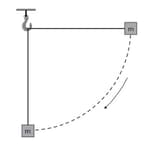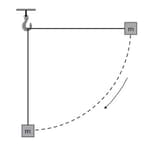A satellite orbits the earth in a circular orbit.The only force on the satellite is the gravitational force from the earth.Which of the following is correct about the acceleration of the satellite?

Important Questions on Circular Motion and Gravitation
Two spherical bodies in the diagram have the same radius but the left mass has twice the mass of the other body. At which point could the net gravitational field of the two masses have the greatest magnitude?
A horizontal disc of radius rotates about a vertical axis through its center. The disc makes one full revolution in .A particle of mass 0.054 kg is placed at a distance from the centre of the disc. The particle does not move relative to the disc. On a copy of the diagram draw arrows to represent the velocity and acceleration of the particle.
A horizontal disc of radius rotates about a vertical axis through its center. The disc makes one full revolution in .A particle of mass is placed at a distance from the centre of the disc. The particle does not move relative to the disc. Calculate the angular speed an linear speed of the particle.
A horizontal disc of radius rotates about a vertical axis through its center. The disc makes one full revolution in .A particle of mass is placed at a distance from the centre of the disc. The particle does not move relative to the disc. The coefficient of static friction between the disc and the particle .Determine the largest distance (in meters) from the centre of disc where the particle can be placed and still not move relative to the disc.
A horizontal disc of radius rotates about a vertical axis through its center. The disc makes one full revolution in .A particle of mass is placed at a distance from the centre of the disc. The particle does not move relative to the disc. The particle is to maintain the original distance from the center of the disc.Determine the maximum angular velocity (in radian per second) of the disc so that the particle does not move relative to the disc.The coefficient of static friction is .
A horizontal disc of radius rotates about a vertical axis through its center. The disc makes one full revolution in .A particle of mass is placed at a distance from the centre of the disc. The particle does not move relative to the disc. The particle is to maintain the original distance from the center of the disc. If the disc rotates with a angular velocity greater than the maximum angular velocity, qualitatively what happens to the particle?
A block of mass is attached to a string of length which is initially horizontal. The mass is then released from a height that is equal to the length of string and it swings as a pendulum. The diagram shows the mass falling to the position where the string is in the vertical position.
Calculate the speed (in meter per second square) of the block when the string is in a vertical position.
A block of mass is attached to a string of length which is initially horizontal. The mass is then released and it swings as a pendulum. The diagram shows the mass falling to the position where the string is in the vertical position.
Speed of the block when the object is in vertical position is Deduce the acceleration of the block (in meter per second square).








